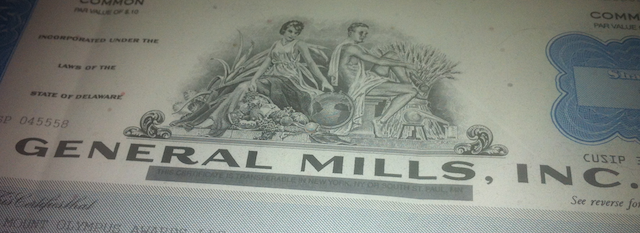Update: This post originally covered a 25-year investment case study of General Mills. Since I am publishing it a few days into the new year, we can look at an additional year of data (all of fiscal 2012) so I modified the figures and compound annual growth rates to account for that extra year, stretching the case study to present day. It might not be as symmetrical but I had planned on publishing this last year.
Last month, I mentioned General Mills in one of my posts. My extended family was over the other day and we were in the kitchen discussing portfolio management. My brother-in-law asked, “Why would anyone buy General Mills?”, when talking about stocks that have what appear to be lower growth and don’t fluctuate all that often. If you were to have opened the newspaper at any time in the past quarter century, General Mills shares would have been stuck between $25 and $75 per share.
[mainbodyad]It’s a good question. General Mills does look boring. It sends a significant portion of the cash it generates each year back to owners in the form of dividends and stock buy backs. It hardly ever generates a story that is important enough to nudge the stock price one way or another. You never see exciting profiles of General Mills in the financial press, or come across interviews with young entrepreneurs who made millions overnight by owning General Mills shares.
Looks are deceiving. It’s better to show, rather than tell, so let’s go back in time 26 years. (I consider an “investing lifetime” to be roughly 50 years, so this period covers half of an investing lifetime and is certainly long enough to have smoothed out the year-to-year vicissitudes common to the stock market.)
What Would Have Happened If You Invested $100,000 In General Mill Shares 26 Years Ago?
Imagine it is the first trading day of 1987. You have $100,000 you want to invest. You decide to buy an ownership stake in General Mills. The stock closed at $29.93 per share. After paying a small commission, you end up with 3,340 shares of the company. You park the stock certificates in a bank vault and ignore them for the next 26 years.
You wake up this morning and decide to go down and take a peak into the vault. What do you have?
- 26,720 shares of General Mills with a market value of $1,102,734
- 10,020 shares of Darden Restaurants with a market value of $454,006
- Cash dividends from your General Mill shares of $466,264
- Cash dividends from your Darden Restaurants shares of $75,082
- Grand Total: $2,098,086
Instead of owning shares of one company, you own shares of two. General Mills spun-off its restaurant division to stockholders by mailing them shares of Darden Restaurants. Darden is the company that owns and operates Red Lobster and The Olive Garden.
Equally as exciting as the $1,556,740 worth of stock you are holding and the $541,346 in cash that has been mailed to you, in fiscal 2013, you should collect at least $55,310 in new cash dividends ($35,270 from General Mills and $20,040 from Darden Restaurants). To put that into perspective, you are now collecting more in passive income each year than the median American family earns with two adults active in the work force.

Your original 3,340 shares would have grown into 26,720 shares of General Mills, 10,020 shares of Darden Restaurants, and $541,346 in cash dividends along the way, all without adding a single extra penny to your initial investment.
Had you reinvested those dividends, you would have made much more money. Even if you didn’t, $541,346 is a lot of cash to enjoy. New cars, vacations, home renovations, college educations for your children … all without touching principal.
A good business, as the saying goes, is the gift that keeps on giving. It showers you with money. That has certainly proven true for General Mills. As people around the world bought Cheerios, Wheaties, and Cinnamon Toast Crunch, baked Betty Crocker cakes, had Pillsbury cinnamon rolls, snacked on Yoplait yogurt, ate Green Giant vegetables, ordered the Tour of Italy, or enjoyed cheddar biscuits with lobster, that money was finding its way into your pocketbook.
General Mills Grew Your Real Purchasing Power By Almost 10% Compounded Annually
General Mills, without reinvesting dividends, gave you a compound annual growth rate of 12.42% before taxes. During that same period, inflation increased 2.87% compounded annually. That means your real purchasing power expanded by 9.55% compounded annually before taxes.
For an asset that required you to do virtually nothing from the moment you signed the check to acquire it, that is the best outcome you have a right to expect. You did nothing for 26 years. You did not show up to an office. You did not work late to come up with new packaging for a product launch. You did not have to cosign business debt. You just owned a piece of the corporate pie.

General Mills owns a portfolio of some of the most iconic food brands in the world. Pillsbury, Chex Mix, Cheerios, Cocoa Puffs, Fiber One, Trix, Old El Paso, Hamburger Helper, Green Giant, Lucky Charms … the list is huge.
Despite this gusher of wealth that has showered down on your family, if you look at General Mill’s stock price, it appears as if it has barely moved in twenty six years. The stock traded for $29.93 back then and for $41.27 today. However, this doesn’t reflect the fact that the company split its stock, sending you more shares. It doesn’t reflect the fact that the company sent out most of the profit in the form of cash dividends. It doesn’t reflect the fact that the firm broke itself into two and mailed you certificates for your ownership of the restaurant division.
You cannot look at the stock price alone. It doesn’t tell you what you need to know in most cases unless 1.) a company refuses to split its stock, 2.) the company doesn’t pay cash dividends, and 3.) the company doesn’t spin-off any holdings. Very few businesses pass all three tests. One famous example is Apple Inc., which only recently began paying a dividend. The company went from around $7 per share in 2003 to $525 per share today. Another example is Berkshire Hathaway, which rose from $8 a share back in the 1960’s to $141,000 per share today. While you should have some firms like that in your portfolio, they are going to be a minority of your equity positions. Most companies don’t behave that way due to the twin combination of the cash expectations of owners and saturation of an existing (albeit, lucrative) market.
The Returns for General Mills Were Good Because the Initial Price Was Reasonable Relative to Earnings and Growth
When you bought your stock in 1987, you only had the previous year’s results to consider, which indicated that General Mills generated a net income of $222 million, or $2.50 per share (adjusting for splits, this is equal to $0.3125 per share today). Compared to your purchase price of $29.93, this meant you were getting an 8.35% earnings yield. At the same time, the 30-year United States Treasury bond was yielding less than 8%.
When you bought your stake, you had look-through earnings of $8,350 (3,340 shares x $2.50 per share in profit). Today, you have look-through earnings of $107,481 ($72,411 of which come from General Mills and $35,070 of which come from Darden Restaurants).
Your look-through earnings increased by 1,287%, or 10.33% compounded annually.
With the benefit of hindsight, we now know the choice you faced in 1987 was to use your $100,000 to make one of two investments:
- Buy a $100,000 30-year United States Treasury bond and collect $8,000 per year, a figure which would never increase or decrease
- Buy a $100,000 ownership stake in General Mills and collect look-through earnings of $8,350 in the first year, increasing by an average of 10.76% thereafter
Of course, at the time, you didn’t know what the growth rate attached to the earnings yield was going to be. That is where the art and discipline of analysis comes into the picture. You have to look at product lines, market share, management teams, tax laws, inflation rates, and a host of other factors. It’s not hard to see, though, that the price paid in 1987 was very fair.
Had you bought the Treasury bond, you would have $100,000 in future claim, which you will receive in 5 years when maturity is reached, and you would have collected $200,000 in interest income.
[mainbodyad]There is a significant difference between turning $100,000 into $300,000 and turning that same amount into nearly $2,100,000. The cost was dealing with the emotional pain of watching your holdings fluctuate in value as other investors bid amongst themselves as to what they were willing to pay for an ownership piece of General Mills.
The Lessons You Should Learn About Portfolio Management from Examining General Mills
Risk is not defined by an asset fluctuating in price. Risk is defined by losing purchasing power. Even if you had split your original $100,000 between General Mills and a company that crashed and burned, such as Enron, you would have still ended up with around $1,050,000 despite one of your two holdings going bankrupt. That is a failure rate of 50%. Regardless, you’d have still walked away with almost a million dollars in profit.
Follow the three rules:
- Pay a rational price relative to earnings and growth.
- Buy a diversified collection of assets that throw off a lot of cash for you to spend, reinvest, give to charity, or save so that if one or more fails, the rest remain unharmed and can restore the damage.
- Hold your ownership in the most tax-efficient way possible.
Time does the rest. Sometimes, the world goes to hell, like you saw during the Great Depression, but if you avoid using debt and always keep enough liquidity on hand to feed your family, you should be fine. Otherwise, too bad. The world isn’t fair. Things don’t always work out as they should. The best you can do is act rationally so that you increase the probability of outcomes that you find favorable.
Don’t forget to pay attention to businesses like General Mills. It can be a temptation to skip over them when looking through list of potential new holdings for your portfolio. They never seem to do anything, causing impatient investors to sell their stock after a few years of seemingly non-movement. These firms are the tortoises of the finance world. While everyone else is paying attention to the hare, they just keep putting one foot in front of the other, churning out fresh cash for their owners as the majority of spectators ignore them.


